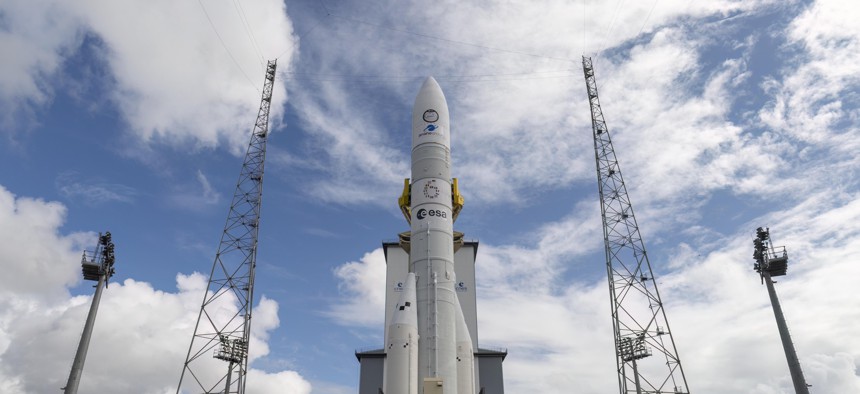
Ariane 6 launch preparation. ESA
Europe’s Space Ambitions Take Center Stage at Paris Air Show 2025
IRIS² Constellation, Copernicus, Galileo, and New Launch Vehicles Signal Europe’s Drive for Sovereignty and Innovation in Space
When the 55th Paris Air Show opens its doors next week, the event will highlight several new initiatives within the Space Market. A major focus will be the European Union's ambitious IRIS² (Infrastructure for Resilience, Interconnectivity, and Security by Satellite) constellation. This multi-orbit network, comprising 264 satellites in Low Earth Orbit (LEO) and 18 in Medium Earth Orbit (MEO), is designed to provide secure, resilient, and cost-efficient governmental communication services while also offering competitive commercial broadband.
IRIS² will be a game-changer for Europe but the constellation will be different from others such as Starlink. While both IRIS² and Starlink leverage satellite technology for connectivity, they embody fundamentally different philosophies and target markets: Starlink, a massive privately-funded mega-constellation with over 7,600 LEO satellites, primarily aims to provide high-speed, low-latency broadband internet directly to consumers and businesses globally, particularly in underserved regions, prioritizing widespread coverage and commercial accessibility. In stark contrast, IRIS², a much smaller, hybrid multi-orbit constellation backed by the European Union, is designed first and foremost to ensure secure, resilient, and independent governmental communication services for Europe, bolstering strategic autonomy and digital sovereignty, with commercial services serving a secondary role to bridge connectivity gaps within Europe and strategically important areas.
This is not the only European program of note.
Copernicus Program: This is the European Union's flagship Earth Observation program, providing free and open access to data and information about our planet. It relies on a constellation of Sentinel satellites (e.g., Sentinel-1 for radar imaging, Sentinel-2 for optical imagery, Sentinel-3 for ocean and land monitoring, and various other Sentinel satellites providing different capabilities) and in-situ measurements to monitor climate change, manage environmental challenges, and support emergency response. Copernicus is a leader in providing "big space data" for a vast array of applications, from urban planning to agricultural monitoring.
Galileo Navigation System: Europe's own Global Navigation Satellite System (GNSS), Galileo provides accurate, reliable, and precise positioning, navigation, and timing services. Independent of other global navigation systems, Galileo offers a highly accurate signal, essential for critical applications in transport, agriculture, and search and rescue. Its continuous development and deployment of new satellites aim to enhance its capabilities and ensure its long-term operational resilience.
EUMETSAT Programs: EUMETSAT (European Organisation for the Exploitation of Meteorological Satellites) operates a fleet of meteorological satellites that provide vital data for weather forecasting and climate monitoring. Their next-generation programs, such as Meteosat Third Generation (MTG) and the EUMETSAT Polar System – Second Generation (EPS-SG), are set to deliver enhanced observations of Earth's atmosphere, land, oceans, and ice, supporting advanced weather prediction and climate change research.
Ariane Launch Vehicle Family: This is Europe's independent access to space. The Ariane family of expendable launch vehicles, with its latest iteration being the Ariane 6 (Ariane 5 has been retired), provides capabilities for launching a wide range of payloads into various orbits, including geostationary transfer orbit (GTO) for telecommunications satellites and low Earth orbit (LEO) for Earth observation and constellation deployments. The development of Ariane 6 focuses on increased flexibility, cost-effectiveness, and responsiveness to meet evolving market demands for commercial and institutional missions. Related to this is the Vega-C launcher, optimized for smaller payloads to LEO.
New Rockets: There are new European launch vehicles coming to market that will change the launch landscape moving forward. Light rockets being developed in the UK, Spain and Germany will give the continent more options to bring payloads to orbit. Germany's ISAR Spectrum rocket suffered a failure on its inaugural launch and Rocket Factory Augsburg ONE failed a test firing of its engine. Despite these setbacks, which are common in spaceflight, progress is being made to bring these vehicles to market.
Spain's PLD Space's MIURA 5 is set to launch in 2026 and the UK's Skyrora XL as well. Although these are relatively light rockets in terms of payload capacity, Europe and commercial companies must start somewhere. If Rocket Lab is used as an example, their Electron rocket, their light offering, has launched well before Neutron, which has yet to launch. These smaller rockets will lead the way for Europe to develop larger vehicles.
In the increasingly competitive and geopolitically sensitive domain of space, the importance of sovereign launch capability for Europe cannot be overstated. Relying on other nations for access to space introduces significant vulnerabilities, including potential restrictions on payload type, launch schedules, and access to sensitive technologies, all of which can compromise Europe's strategic autonomy. Independent launch capabilities, exemplified by the Ariane and Vega-C rocket families, ensure that Europe can deploy its critical assets, such as the Galileo navigation satellites, Copernicus Earth observation satellites, and the upcoming IRIS² secure communication constellation, without external political or commercial influence. This self-reliance is crucial for maintaining control over sensitive data, enabling rapid response to security threats or natural disasters, and fostering the growth of Europe's own robust space industrial base, encompassing everything from manufacturing to ground operations.
As the Paris Air Show 2025 unfolds, it's clear that the European Union is not merely a participant but a proactive force in shaping the next era of Space. From the strategic imperative of the IRIS² constellation to the invaluable environmental monitoring of Copernicus, the precise navigation of Galileo, the independent launch capabilities of the Ariane and Vega-C families, new rockets coming to market and the critical meteorological insights from EUMETSAT, Europe's collective space efforts demonstrate a profound commitment to technological advancement, economic growth, and enhanced security. These programs, distinct in their objectives yet unified in their ambition, underscore Europe's dedication to fostering innovation, ensuring digital autonomy, and leveraging the power of space for the benefit of its citizens and the global community. The advancements showcased at this event will undoubtedly serve as a testament to Europe's growing influence and vision in the ever-expanding cosmic frontier.
NEXT STORY: Guowang Goes Gigascale
